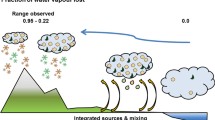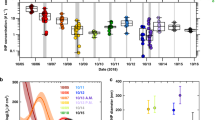Abstract
A series of measurements of ice-nucleating particles (INPs) were performed at two sites in Beijing. At the Beijing Meteorological Service (BMS) site, which was an urban site, no INPs were found to be active above–15°C. However, at the Yanjiaping (YJP) site, which was a rural site, the concentration of INPs active at temperatures above–15°C was found to be as high as 1.73 g–1. Two parameterizations were constructed by respectively fitting the data obtained at BMS site and YJP site. The two parameterizations, as well as another parameterization from the literature, were implemented into a parcel model to investigate the effect of INPs active above–15°C on phase partitioning in mixed-phase clouds. At a vertical velocity of 0.01 m s–1, which is typical for stratiform clouds associated with frontal systems, the INPs active above–15°C nucleate ice crystals at low levels. The growth of these ice crystals remarkably reduces both the maximum liquid water mixing ratio and the altitude where the maximum liquid water mixing ratio is reached. When the vertical velocity of the parcel is increased to 0.1 m s–1 or an even higher value, the evolution of liquid water mixing ratio is not controlled by the INPs active above–15°C but those active below–15°C.
Similar content being viewed by others
References
Atkinson, J. D., B. J. Murray, M. T. Woodhouse, et al.,2013: The importance of feldspar for ice nucleation by mineral dust in mixed-phase clouds. Nature, 498, 355–358, doi: 10.1038/nature12278.
Bigg, E. K., 1957: A new technique for counting ice-forming nuclei in aerosols. Tellus, 9, 394–400, doi: 10.1111/j.2153-3490. 1957.tb01895.x.
Burrows, S. M., C. Hoose, U. Pöschl, et al.,2013: Ice nuclei in marine air: Biogenic particles or dust? Atmos. Chem. Phys., 13, 245–267, doi: 10.5194/acp-13-245-2013.
Chen, J., Z. J. Wu, S. Augustin-Bauditz, et al.,2018: Ice-nucleating particle concentrations unaffected by urban air pollution in Beijing, China. Atmos. Chem. Phys., 18, 3523–3539, doi: 10.5194/acp-18-3523-2018.
DeMott, P. J., 1990: An exploratory study of ice nucleation by soot aerosols. J. Appl. Meteor., 29, 1072–1079, doi: 10.1175/1520-0450(1990)029<1072:AESOIN>2.0.CO;2.
DeMott, P. J., A. J. Prenni, X. Liu, et al.,2010: Predicting global atmospheric ice nuclei distributions and their impacts on climate. Proc. Natl. Acad. Sci. USA, 107, 11217–11222, doi: 10.1073/pnas.0910818107.
Durran, D. R., and L. W. Snellman, 1987: The diagnosis of synoptic-scale vertical motion in an operational environment. Wea. Forecasting, 2, 17–31, doi: 10.1175/1520-0434(1987)002 <0017:TDOSSV>2.0.CO;2.
Flatau, P. J., R. L. Walko, and W. R. Cotton, 1992: Polynomial fits to saturation vapor pressure. J. Appl. Meteor., 31, 1507–1513, doi: 10.1175/1520-0450(1992)031<1507:PFTSVP>2.0.CO;2.
Fu, S. Z., and H. W. Xue, 2017: The effect of ice nuclei efficiency on arctic mixed-phase clouds from large-eddy simulations. J. Atmos. Sci., 74, 3901–3913, doi: 10.1175/JAS-D-17-0112.1.
Hallett, J., and S. C. Mossop, 1974: Production of secondary ice particles during the riming process. Nature, 249, 26–28, doi: 10.1038/249026a0.
Heymsfield, A. J., and S. C. Mossop, 1984: Temperature dependence of secondary ice crystal production during soft hail growth by riming. Quart. J. Roy. Meteor. Soc., 110, 765–770, doi: 10.1002/qj.49711046512.
Hobbs, P. V., and A. J. Alkezweeny, 1968: The fragmentation of freezing water droplets in free fall. J. Atmos. Sci., 25, 881–888, doi: 10.1175/1520-0469(1968)025<0881:TFOFWD >2.0.CO;2.
Hoose, C., J. E. Kristjánsson, J.-P. Chen, et al.,2010: A classical-theory-based parameterization of heterogeneous ice nucleation by mineral dust, soot, and biological particles in a global climate model. J. Atmos. Sci., 67, 2483–2503, doi: 10.1175/2010JAS3425.1.
Huffman, J. A., A. J. Prenni, P. J. DeMott, et al.,2013: High concentrations of biological aerosol particles and ice nuclei during and after rain. Atmos. Chem. Phys., 13, 6151–6164, doi: 10.5194/acp-13-6151-2013.
Jiang, H., Y. Yin, H. Su, et al.,2015: The characteristics of atmospheric ice nuclei measured at the top of Huangshan (the Yellow Mountains) in Southeast China using a newly built static vacuum water vapor diffusion chamber. Atmos. Res., 153, 200–208, doi: 10.1016/j.atmosres.2014.08.015.
Jiang, H., Y. Yin, X. Wang, et al.,2016: The measurement and parameterization of ice nucleating particles in different backgrounds of China. Atmos. Res., 181, 72–80, doi: 10.1016/j.atmosres. 2016.06.013.
Joly, M., P. Amato, L. Deguillaume, et al.,2014: Quantification of ice nuclei active at near 0°C temperatures in low-altitude clouds at the Puy de Dôme atmospheric station. Atmos. Chem. Phys., 14, 8185–8195, doi: 10.5194/acp-14-8185-2014.
Kikuro, T., S. Masaki, W. Kenji, et al.,2015: An example of canal formation in a thick cloud induced by massive seeding using liquid carbon dioxide. J. Meteor. Res., 29, 682–690, doi: 10.1007/s13351-015-5005-y.
Korolev, A., and G. Isaac, 2003: Phase transformation of mixedphase clouds. Quart. J. Roy. Meteor. Soc., 129, 19–38, doi: 10.1256/qj.01.203.
Korolev, A., and P. R. Field, 2008: The effect of dynamics on mixed-phase clouds: Theoretical considerations. J. Atmos. Sci., 65, 66–86, doi: 10.1175/2007JAS2355.1.
Lamb, D., and J. Verlinde, 2011: Physics and Chemistry of Clouds. Cambridge University Press, Cambridge, United Kingdom, 584 pp.
Li, Z., H. W. Xue, and F. Yang, 2013: A modeling study of ice formation affected by aerosols. J. Geophys. Res. Atmos., 118, 11213–11227, doi: 10.1002/jgrd.50861.
Lohmann, U., 2002: A glaciation indirect aerosol effect caused by soot aerosols. Geophys. Res. Lett., 29, 11-1–11-4, doi: 10.10 29/2001GL014357.
Ma, X. C., K. Bi, Y. B. Chen, et al.,2017: Characteristics of winter clouds and precipitation over the mountains of northern Beijing. Adv. Meteor., 2017, 3536107, doi: 10.1155/2017/3536107.
Masaki, S., T. Kikuro, and N. Koji, 2016: Model analysis of radar echo split observed in an artificial cloud seeding experiment. J. Meteor. Res., 30, 386–400, doi: 10.1007/s13351-016-5053-y.
Meyers, M. P., P. J. DeMott, and W. R. Cotton, 1992: New primary ice-nucleation parameterizations in an explicit cloud model. J. Appl. Meteor., 31, 708–721, doi: 10.1175/1520-0450(1992)031<0708:NPINPI>2.0.CO;2.
Mossop, S. C., and J. Hallett, 1974: Ice crystal concentration in cumulus clouds: Influence of the drop spectrum. Science, 186, 632–634, doi: 10.1126/science.186.4164.632.
Murray, B. J., S. L. Broadley, T. W. Wilson, et al.,2011: Heterogeneous freezing of water droplets containing kaolinite particles. Atmos. Chem. Phys., 11, 4191–4207, doi: 10.5194/acp-11-4191-2011.
O’Sullivan, D., B. J. Murray, T. L. Malkin, et al.,2014: Ice nucleation by fertile soil dusts: Relative importance of mineral and biogenic components. Atmos. Chem. Phys., 14, 1853–1867, doi: 10.5194/acp-14-1853-2014.
Ovchinnikov, M., A. S. Ackerman, A. Avramov, et al.,2014: Intercomparison of large-eddy simulations of Arctic mixedphase clouds: Importance of ice size distribution assumptions. J. Adv. Model. Earth Syst., 6, 223–248, doi: 10.1002/2013MS000282.
Prenni, A. J., P. J. DeMott, D. C. Rogers, et al.,2009: Ice nuclei characteristics from M-PACE and their relation to ice formation in clouds. Tellus, 61, 436–448, doi: 10.1111/j.1600-0889.2009.00415.x.
Savre, J., and A. M. L. Ekman, 2015: Large-eddy simulation of three mixed-phase cloud events during ISDAC: Conditions for persistent heterogeneous ice formation. J. Geophys. Res. Atmos., 120, 7699–7725, doi: 10.1002/2014JD023006.
Schnell, R. C., and G. Vali, 1976: Biogenic ice nuclei: Part I. Terrestrial and marine sources. J. Atmos. Sci., 33, 1554–1564, doi: 10.1175/1520-0469(1976)033<1554:BINPIT>2.0.CO;2.
Sesartic, A., U. Lohmann, and T. Storelvmo, 2013: Modelling the impact of fungal spore ice nuclei on clouds and precipitation. Environ. Res. Lett., 8, 014029, doi: 10.1088/1748-9326/8/1/014029.
Solomon, A., G. Feingold, and M. D. Shupe, 2015: The role of ice nuclei recycling in the maintenance of cloud ice in Arctic mixed-phase stratocumulus. Atmos. Chem. Phys., 15, 10,631–10,643, doi: 10.5194/acp-15-10631-2015.
Sulia, K. J., and J. Y. Harrington, 2011: Ice aspect ratio influences on mixed-phase clouds: Impacts on phase partitioning in parcel models. J. Geophys. Res. Atmos., 116, D21309, doi: 10.1029/2011JD016298.
Thompson, G., and T. Eidhammer, 2014: A study of aerosol impacts on clouds and precipitation development in a large winter cyclone. J. Atmos. Sci., 71, 3636–3658, doi: 10.1175/JAS-D-13-0305.1.
Vali, G., M. Christensen, R. W. Fresh, et al.,1976: Biogenic ice nuclei. Part II: Bacterial sources. J. Atmos. Sci., 33, 1565–1570, doi: 10.1175/1520-0469(1976)033<1565:BINPIB>2.0. CO;2.
Vali, G., P. J. DeMott, O. Möhler, et al.,2015: Technical Note: A proposal for ice nucleation terminology. Atmos. Chem. Phys., 15, 10263–10270, doi: 10.5194/acp-15-10263-2015.
Wang, D. H., J. F. Yin, and G. Q. Zhai, 2015: In-situ measurements of cloud–precipitation microphysics in the East Asian monsoon region since 1960. J. Meteor. Res., 29, 155–179, doi: 10.1007/s13351-015-3235-7.
Xue, H. W., and G. Feingold, 2004: A modeling study of the effect of nitric acid on cloud properties. J. Geophys. Res. Atmos., 109, D18204, doi: 10.1029/2004JD004750.
Yang, S. Z., X. F. Lou, G. Huang, et al.,2007: A 15 L mixing cloud chamber for testing ice nuclei. J. Appl. Meteor. Sci., 18, 716–721. (in Chinese)
Young, K. C., 1974: The role of contact nucleation in ice phase initiation in clouds. J. Atmos. Sci., 31, 768–776, doi: 10.1175/1520-0469(1974)031<0768:TROCNI>2.0.CO;2.
Zeng, X. P., W.-K. Tao, M. H. Zhang, et al.,2009: An indirect effect of ice nuclei on atmospheric radiation. J. Atmos. Sci., 66, 41–61, doi: 10.1175/2008JAS2778.1.
Acknowledgements
We are grateful to Deping Ding for initiating the collaboration between Beijing Weather Modification Office and Peking University.
Author information
Authors and Affiliations
Corresponding author
Additional information
Supported by the National Natural Science Foundation of China (41775138 and 41330421), Natural Science Foundation of Beijing (8172023), Beijing Municipal Science and Technology Commission (D171100000717001), and Science and Technology Project of Beijing Meteorological Service (BMBKJ201701007).
Rights and permissions
About this article
Cite this article
Bi, K., Ma, X., Chen, Y. et al. The Observation of Ice-Nucleating Particles Active at Temperatures above–15°C and Its Implication on Ice Formation in Clouds. J Meteorol Res 32, 734–743 (2018). https://doi.org/10.1007/s13351-018-7181-z
Received:
Accepted:
Published:
Issue Date:
DOI: https://doi.org/10.1007/s13351-018-7181-z




